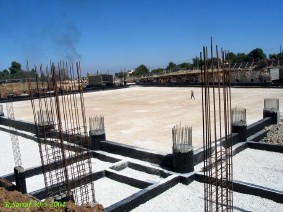Personal tools
News from ICTP 109 - Commentary

A dream that began in 1997 will turn into a reality in 2009. More than halfway through their journey, proponents of the SESAME project have a great deal to celebrate and a great deal more work to do.
Open SESAME
The Fourth Meeting of the Council
of the SESAME project (Synchrotron-light for Experimental Science
and Applications in the Middle East) took place at ICTP on 13-14
July 2004. Council president Herwig Schopper, former Director-General
of CERN (European Organization for Nuclear Research) and one of
the guiding lights for SESAME since the project's earliest days,
presided over the discussion.
The SESAME project will lead to the construction--or, more precisely,
the reconstruction--of the first synchrotron radiation light facility
in the Middle East (see "Two Steps Closer," News from ICTP,
Autumn 2002, p. 3).

In 1999, the German government announced that it would be willing
to donate its decommissioned synchrotron-light facility, BESSY
I, to a developing country or region. Three years later, a group
of institutions, led by UNESCO, arranged for BESSY I to be shipped
from Germany to Jordan. SESAME's official groundbreaking ceremony,
took place on 6 January 2003 in Allan, Jordan (30 kilometres northwest
of Amman), where King Abdullah II of Jordan laid the cornerstone
for the future complex. Jordan has not only donated the land for
the project but has pledged more than US$5 million for upgrading
and housing the facility.
The beams generated by the upgraded BESSY I will cover a broad
range of the electromagnetic spectrum--from infrared to hard x-rays--casting
light, for example, on the study of molecular biology, material
science, the environment and archaeological microanalysis. More
than 1000 scientists a year are expected to conduct research at
SESAME when it becomes fully operational in 2009.
"The inspiration for SESAME," Schopper recently noted,
"rests with two organizations that share the same vision:
CERN, which was built in the 1950s to promote peace and harmony
in post World War II Europe through scientific exchange; and ICTP,
whose mandate is to serve as a forum for scientific exchange and
cross-cultural dialogue primarily through efforts to promote science
in the developing world. Indeed if not for the research and training
activities that ICTP has sponsored over the past four decades,
it's unlikely the Middle East would have developed the scientific
wherewithal to take advantage of SESAME."
"Since 2000," Schopper adds, "ICTP has also had
lead responsibility for organizising the training of engineers
who have subsequently been put to work on efforts to upgrade and
expand BESSY I from 0.8 GEV to 2.5 GEV." Training has taken
place at synchrotron facilities across Europe, including the Elettra
facility in Trieste. Overall administration for this part of the
SESAME project has been given to ICTP under the direction of the
Centre's long-time staff scientist Gallieno Denardo.
"At first, we thought the reconstruction of the facility
would have to be done by the experts who had dismantled BESSY
I," notes Schopper. "However, the skill levels of the
SESAME trainees advanced so rapidly that we were able to change
course and turn to our own trainees to do the job. As a result,
we have successfully tapped the talents of the region's technologists
even before the facility has begun its operation. This is an extra
bonus we did not expect."
Schopper now hopes to follow the same course in the construction
of SESAME's first six beam lines. If all goes according to plan,
ICTP will again be asked to manage the training programme. At
the same time, synchrotron facilities throughout Europe will again
be called on to host young Middle Eastern scientists who--upon
successful completion of their training--will be recruited to
work on the SESAME project.
"Thanks to both inspiration and hands-on help that institutions
like ICTP have given to SESAME, the project is on track. We only
hope that we can achieve the same level of success and impact
of the two institutions that have inspired this effort in the
first place: CERN and ICTP."
For additional information about SESAME, see www.sesame.org.jo.